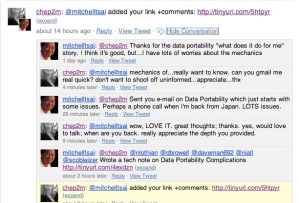Facebook added a new “questions” feature to my profile today.
And apparently you don’t either, or you might have asked, “Hey…people! What features do YOU want to see on Facebook?”
See, if you asked that question, maybe you’d give me the service that I want to use – not the one that you want to deliver. And, based upon past history, the service that you want to deliver is often one that could benefit from a second opinion.
Mark, make Facebook useful to me. Help me harness it to capture the intelligence and insight of my network of friends in the ways that I want it.
Help me weight my friends by the value of their feeds so that I can see more of some people and less of others. I know that I can “hide” people, but what if I just want to turn them down? Or up? If I knew that posts from my most helfpful friends would stream onto my feed more efficiently, heck, I’d make more use of your service.
Let me put 5 stars on the stuff that I like and none on the stuff that I don’t, and use that info to filter and weight what I see on Facebook over time.
Help me see my friends’ updates on time. I was excited to have news pop up on my feed that my friend Gopal was having coffee just across the street from where I was. But – 00ps – he’d posted that update eight hours before it popped onto my screen. Glad I didn’t dash over…chances are he’d finished his latte in that time.
(An eight-hour-old update? In the age of Twitter and Gowalla and FourSquare? I have trouble wrapping my head around that concept.)
If my “stars” help you know who my favorite people are, you’d know that I want to hear from them pretty quickly, and – wa-la! – I’d have a whole new level of value on my feed.
Help me manage my friends without multiple clicks, links, and page refreshes. Right now, setting up my friend levels is a painful, time-consuming, one-by-one process that’s unparalleled in its slowness and lack of clarity. Set up a screen that displays multiple friends and let me radio-button or otherwise check the “level” of access I want them to have.
Make it easy for me to fine-tune and I’ll say “yes” to those friend requests that are waiting in my queue. I don’t want to accept them til I set up the right levels of access, and it’s so cumbersome and confusing that I don’t have time to do it. Ask me and I’ll show you services that do this really really well. Do it like they do and Facebook will be much more useful for me.
Give me back the control I had in 2007 and 2008 where I could “turn up” or “turn down” the types of content that streamed on my feed. If I didn’t want photos, or relationship updates, or who-friended-who, I could move levers around on a control panel and my feed would respond accordingly. I still don’t want to know who friended whom. But it shows up anyway, overriding posts and content that could actually offer me value. I – not you – should get to decide what streams on my feed. Long term, that makes me a more satisfied, active, and (thus) valuable user of your service.
And what’s with a product that’s actually more clunky in 2010 than it was in 2007? Ooops, sorry: that was a question.
(Side note: A few years back, I frequently spoke at professional gatherings, business meetings, webinars and more on “The Business Value of Facebook,” helping professionals understand how to build and learn from the networks they built on your service. I also spoke on “Facebook for Parents,” encouraging moms and dads to relax about their kids’ use of Facebook and to sign up for accounts themselves. Sometimes 200, maybe 300 people in the audience would open Facebook accounts, real-time, during my talk. I loved it.
I stopped giving those talks because I just couldn’t convince myself (and ergo an audience) that there was any business value in using Facebook. The inability to fine-tune features and privacy and the movement to blare on the news feed made me eliminate those talks from my repertoire. Things just felt wrong on a gut level; as it turns out, recent research says this was more than a feeling.)
Mark, make me feel like Facebook is a cool place where I want to share and preserve information for a very long time. Do that by taking everything I’ve said above and inverting it so that the people who care about me see my information, and see it on time. I recently posted news of a job change on my Facebook profile. One of my close friends, who logs onto Facebook 4 or more times a day never even saw this in his feed! What a lost opportunity for both of us.
Set things up so that my “Limited Profile” is all people can see when we’re not connected – again, like you did up until 2009. Did you know that when a person I’ve put on Limited Profile “unfriends” me that, poof, suddenly they can see my entire public profile? They see more as a stranger than they do as a friend! Concept #2 that I just can’t get my head around.
Don’t shove the same stuff into my feed again and again if I don’t respond to it. I didn’t watch “Jane Austen’s Fight Club” when it showed up this morning and I’m not going to watch it now. In the meantime, my friend John Hagel has posted an article about neuroscience that’s right up my alley…but, ironically, nowhere on my feed.
Give me back local. I loved seeing what was happening in and around my hometown; it connected me to things I might have otherwise missed and now look for on Meetup and Twitter.
Make ads relevant to me. Really! Who has more information about my likes and dislikes than you, Mark? Who knows the type of friends I hang out with, the things I click on when they post, even what my conversations and status updates suggest about my love life? And yet you serve me (wait, let me look) something about a PPC search network? I wish that your Irrelevant/Uninteresting/Repetitive choices when I “X” out ads had an “All of the Above.” I’m never going to click on that, and if you paid attention to that, over time you might attract some advertisers I’d actually respond to.
Mark, there’s more, but this is enough for now. I’ve come so close to pushing that “deactivate” button, but I gotta confess: you have me over a barrel. My kids are there, my sisters and brothers, my co-workers, my adorable Uncle Harvey and my high school friends and people I’ve met in my travels; they’re all there. Some of them also see Facebook as the online application we most hate to love; I’m right there with all of those folks who are highly dissatisfied but can’t bear to log off.
I’m just one of your 500 million users, but somehow I think there are a few others who think like me – and maybe we’re the people you should be listening to.
But I could be wrong. I’d like to know. So…what do you say? Ask the question, Mark. And then give us the service our answers describe.



